air conditioning CHEVROLET KODIAK 2008 Owners Manual
[x] Cancel search | Manufacturer: CHEVROLET, Model Year: 2008, Model line: KODIAK, Model: CHEVROLET KODIAK 2008Pages: 384, PDF Size: 5.4 MB
Page 140 of 384
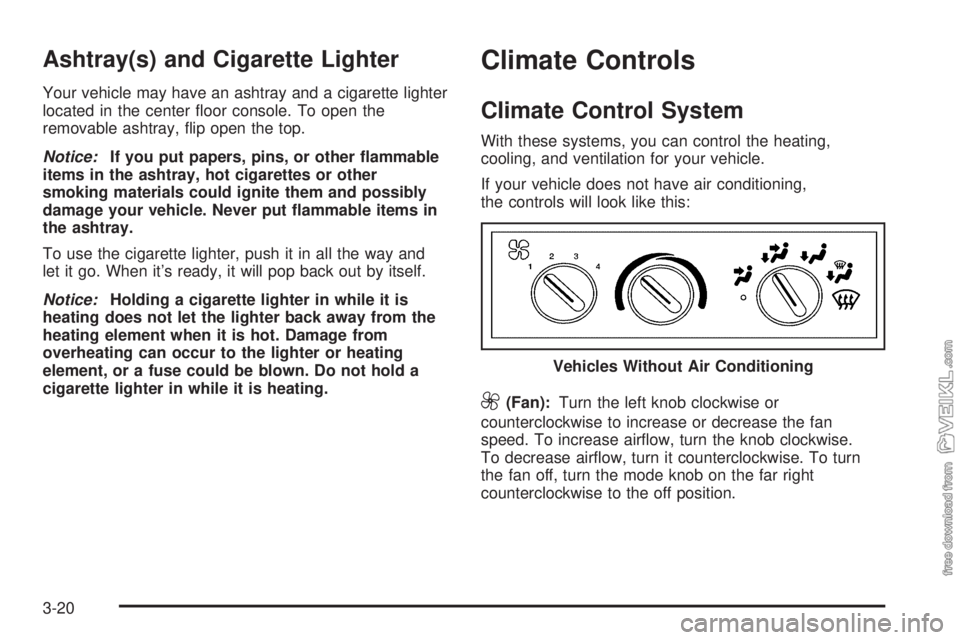
Ashtray(s) and Cigarette Lighter
Your vehicle may have an ashtray and a cigarette lighter
located in the center floor console. To open the
removable ashtray, flip open the top.
Notice:If you put papers, pins, or other �ammable
items in the ashtray, hot cigarettes or other
smoking materials could ignite them and possibly
damage your vehicle. Never put �ammable items in
the ashtray.
To use the cigarette lighter, push it in all the way and
let it go. When it’s ready, it will pop back out by itself.
Notice:Holding a cigarette lighter in while it is
heating does not let the lighter back away from the
heating element when it is hot. Damage from
overheating can occur to the lighter or heating
element, or a fuse could be blown. Do not hold a
cigarette lighter in while it is heating.
Climate Controls
Climate Control System
With these systems, you can control the heating,
cooling, and ventilation for your vehicle.
If your vehicle does not have air conditioning,
the controls will look like this:
9(Fan):Turn the left knob clockwise or
counterclockwise to increase or decrease the fan
speed. To increase airflow, turn the knob clockwise.
To decrease airflow, turn it counterclockwise. To turn
the fan off, turn the mode knob on the far right
counterclockwise to the off position.Vehicles Without Air Conditioning
3-20
Page 141 of 384
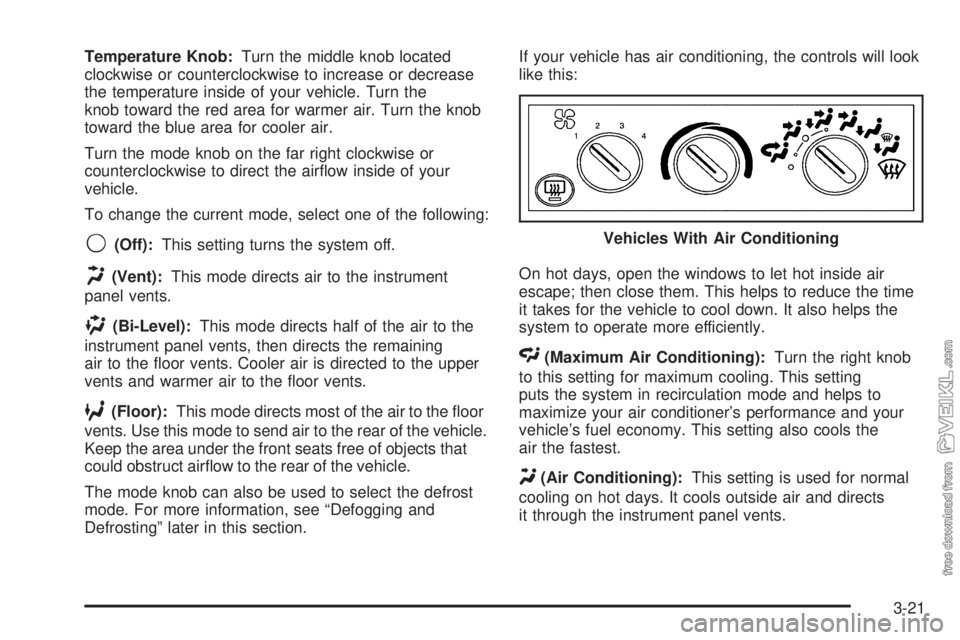
Temperature Knob:Turn the middle knob located
clockwise or counterclockwise to increase or decrease
the temperature inside of your vehicle. Turn the
knob toward the red area for warmer air. Turn the knob
toward the blue area for cooler air.
Turn the mode knob on the far right clockwise or
counterclockwise to direct the airflow inside of your
vehicle.
To change the current mode, select one of the following:
9(Off):This setting turns the system off.
H(Vent):This mode directs air to the instrument
panel vents.
)(Bi-Level):This mode directs half of the air to the
instrument panel vents, then directs the remaining
air to the floor vents. Cooler air is directed to the upper
vents and warmer air to the floor vents.
6(Floor):This mode directs most of the air to the floor
vents. Use this mode to send air to the rear of the vehicle.
Keep the area under the front seats free of objects that
could obstruct airflow to the rear of the vehicle.
The mode knob can also be used to select the defrost
mode. For more information, see “Defogging and
Defrosting” later in this section.If your vehicle has air conditioning, the controls will look
like this:
On hot days, open the windows to let hot inside air
escape; then close them. This helps to reduce the time
it takes for the vehicle to cool down. It also helps the
system to operate more efficiently.
<(Maximum Air Conditioning):Turn the right knob
to this setting for maximum cooling. This setting
puts the system in recirculation mode and helps to
maximize your air conditioner’s performance and your
vehicle’s fuel economy. This setting also cools the
air the fastest.
Y(Air Conditioning):This setting is used for normal
cooling on hot days. It cools outside air and directs
it through the instrument panel vents.Vehicles With Air Conditioning
3-21
Page 142 of 384
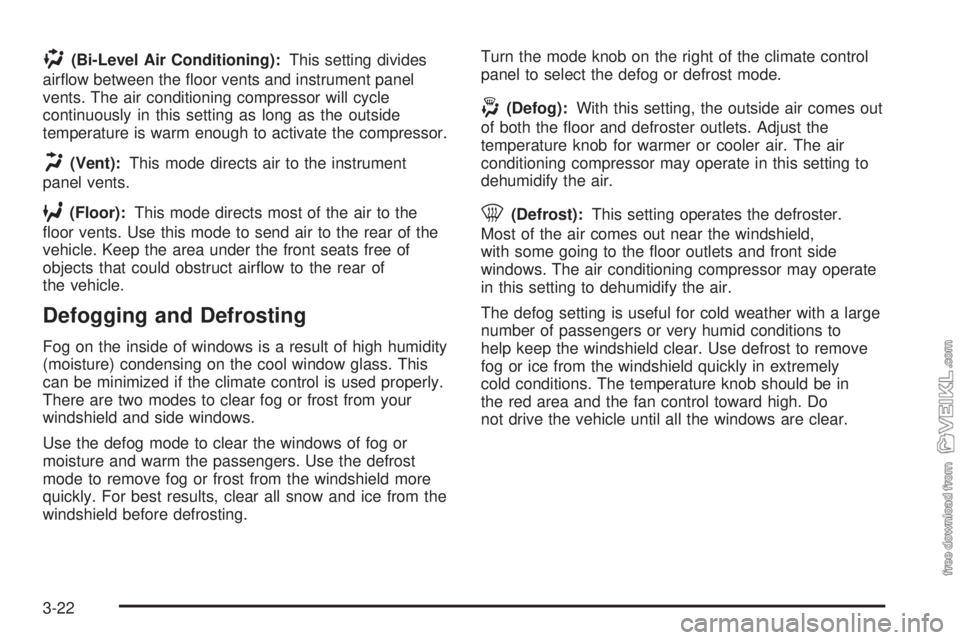
)(Bi-Level Air Conditioning):This setting divides
airflow between the floor vents and instrument panel
vents. The air conditioning compressor will cycle
continuously in this setting as long as the outside
temperature is warm enough to activate the compressor.
H(Vent):This mode directs air to the instrument
panel vents.
6(Floor):This mode directs most of the air to the
floor vents. Use this mode to send air to the rear of the
vehicle. Keep the area under the front seats free of
objects that could obstruct airflow to the rear of
the vehicle.
Defogging and Defrosting
Fog on the inside of windows is a result of high humidity
(moisture) condensing on the cool window glass. This
can be minimized if the climate control is used properly.
There are two modes to clear fog or frost from your
windshield and side windows.
Use the defog mode to clear the windows of fog or
moisture and warm the passengers. Use the defrost
mode to remove fog or frost from the windshield more
quickly. For best results, clear all snow and ice from the
windshield before defrosting.Turn the mode knob on the right of the climate control
panel to select the defog or defrost mode.
-(Defog):With this setting, the outside air comes out
of both the floor and defroster outlets. Adjust the
temperature knob for warmer or cooler air. The air
conditioning compressor may operate in this setting to
dehumidify the air.
0(Defrost):This setting operates the defroster.
Most of the air comes out near the windshield,
with some going to the floor outlets and front side
windows. The air conditioning compressor may operate
in this setting to dehumidify the air.
The defog setting is useful for cold weather with a large
number of passengers or very humid conditions to
help keep the windshield clear. Use defrost to remove
fog or ice from the windshield quickly in extremely
cold conditions. The temperature knob should be in
the red area and the fan control toward high. Do
not drive the vehicle until all the windows are clear.
3-22
Page 143 of 384
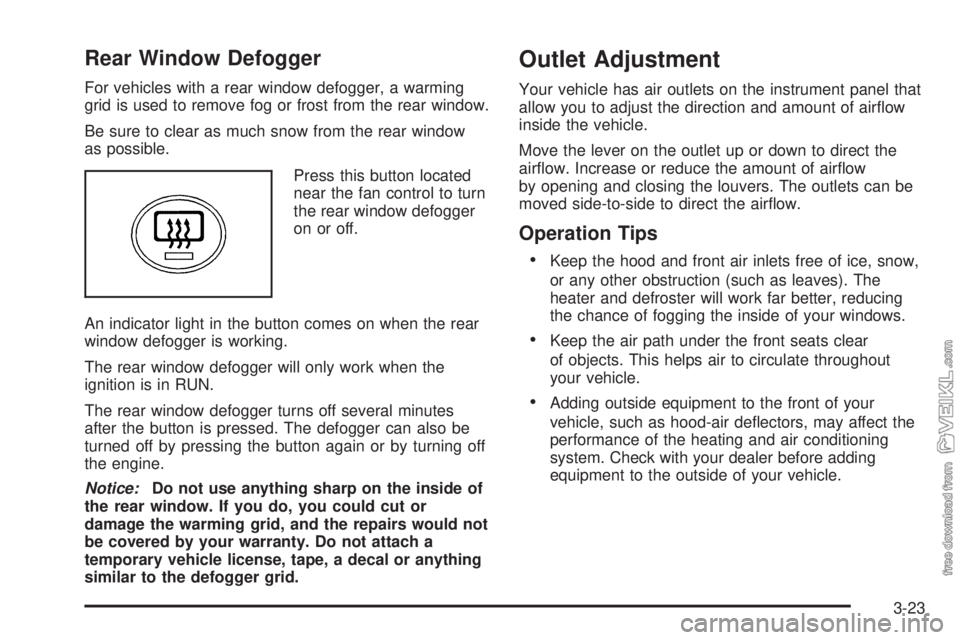
Rear Window Defogger
For vehicles with a rear window defogger, a warming
grid is used to remove fog or frost from the rear window.
Be sure to clear as much snow from the rear window
as possible.
Press this button located
near the fan control to turn
the rear window defogger
on or off.
An indicator light in the button comes on when the rear
window defogger is working.
The rear window defogger will only work when the
ignition is in RUN.
The rear window defogger turns off several minutes
after the button is pressed. The defogger can also be
turned off by pressing the button again or by turning off
the engine.
Notice:Do not use anything sharp on the inside of
the rear window. If you do, you could cut or
damage the warming grid, and the repairs would not
be covered by your warranty. Do not attach a
temporary vehicle license, tape, a decal or anything
similar to the defogger grid.
Outlet Adjustment
Your vehicle has air outlets on the instrument panel that
allow you to adjust the direction and amount of airflow
inside the vehicle.
Move the lever on the outlet up or down to direct the
airflow. Increase or reduce the amount of airflow
by opening and closing the louvers. The outlets can be
moved side-to-side to direct the airflow.
Operation Tips
•
Keep the hood and front air inlets free of ice, snow,
or any other obstruction (such as leaves). The
heater and defroster will work far better, reducing
the chance of fogging the inside of your windows.
•Keep the air path under the front seats clear
of objects. This helps air to circulate throughout
your vehicle.
•Adding outside equipment to the front of your
vehicle, such as hood-air deflectors, may affect the
performance of the heating and air conditioning
system. Check with your dealer before adding
equipment to the outside of your vehicle.
3-23
Page 308 of 384
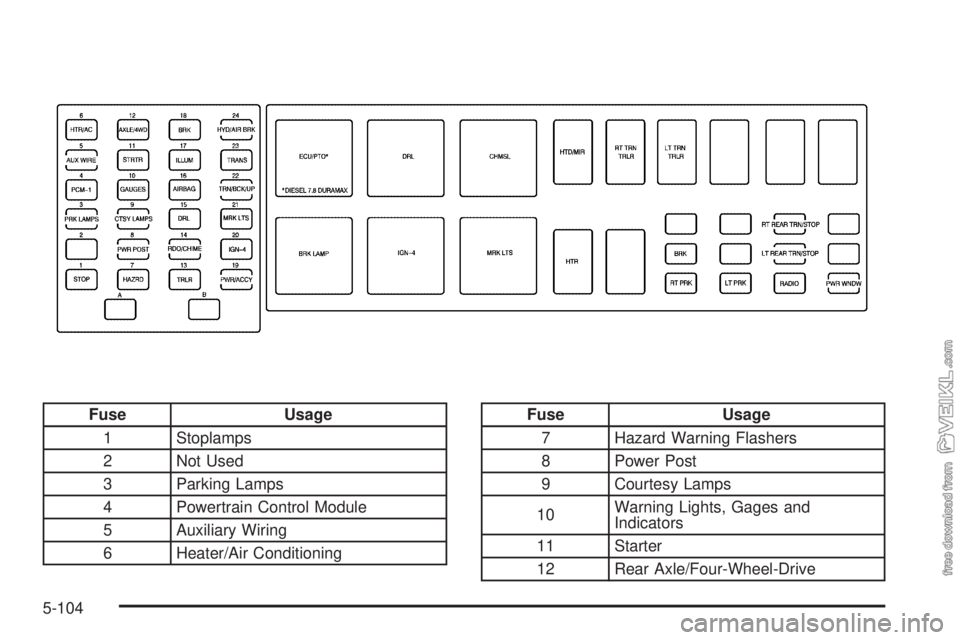
Fuse Usage
1 Stoplamps
2 Not Used
3 Parking Lamps
4 Powertrain Control Module
5 Auxiliary Wiring
6 Heater/Air ConditioningFuse Usage
7 Hazard Warning Flashers
8 Power Post
9 Courtesy Lamps
10Warning Lights, Gages and
Indicators
11 Starter
12 Rear Axle/Four-Wheel-Drive
5-104
Page 311 of 384
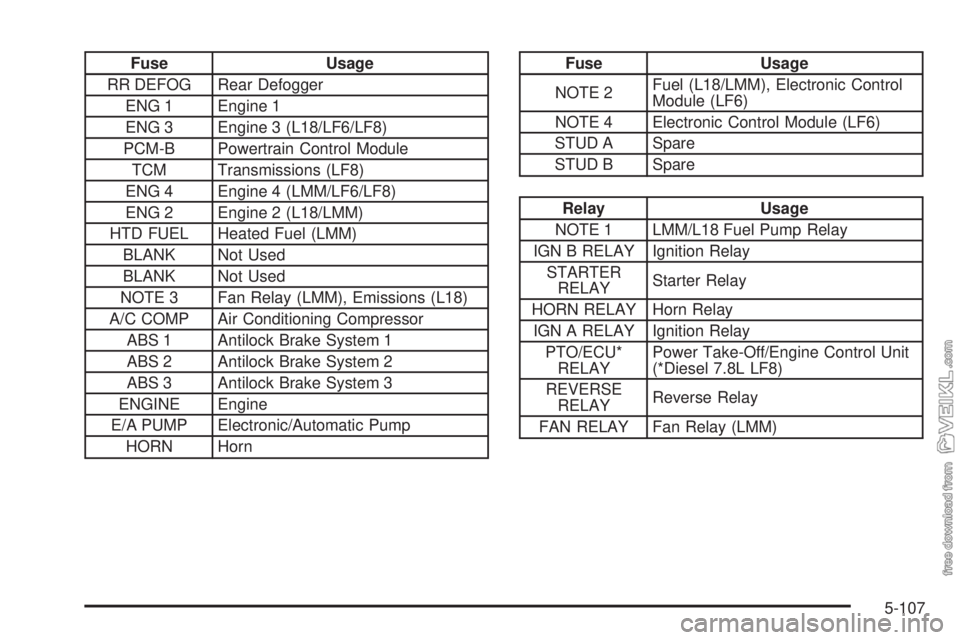
Fuse Usage
RR DEFOG Rear Defogger
ENG 1 Engine 1
ENG 3 Engine 3 (L18/LF6/LF8)
PCM-B Powertrain Control Module
TCM Transmissions (LF8)
ENG 4 Engine 4 (LMM/LF6/LF8)
ENG 2 Engine 2 (L18/LMM)
HTD FUEL Heated Fuel (LMM)
BLANK Not Used
BLANK Not Used
NOTE 3 Fan Relay (LMM), Emissions (L18)
A/C COMP Air Conditioning Compressor
ABS 1 Antilock Brake System 1
ABS 2 Antilock Brake System 2
ABS 3 Antilock Brake System 3
ENGINE Engine
E/A PUMP Electronic/Automatic Pump
HORN HornFuse Usage
NOTE 2Fuel (L18/LMM), Electronic Control
Module (LF6)
NOTE 4 Electronic Control Module (LF6)
STUD A Spare
STUD B Spare
Relay Usage
NOTE 1 LMM/L18 Fuel Pump Relay
IGN B RELAY Ignition Relay
STARTER
RELAYStarter Relay
HORN RELAY Horn Relay
IGN A RELAY Ignition Relay
PTO/ECU*
RELAYPower Take-Off/Engine Control Unit
(*Diesel 7.8L LF8)
REVERSE
RELAYReverse Relay
FAN RELAY Fan Relay (LMM)
5-107
Page 313 of 384
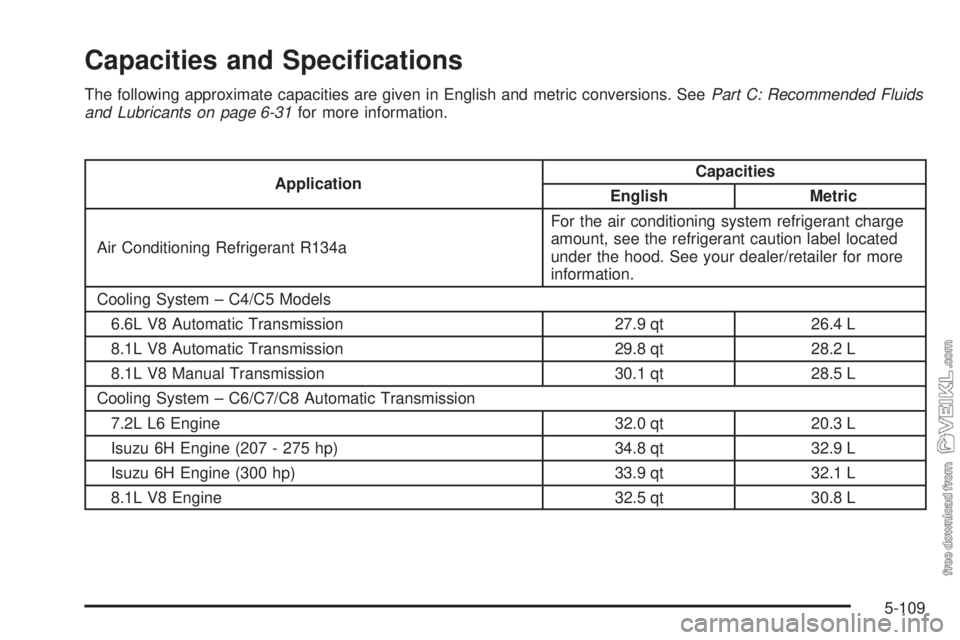
Capacities and Speci�cations
The following approximate capacities are given in English and metric conversions. SeePart C: Recommended Fluids
and Lubricants on page 6-31for more information.
ApplicationCapacities
English Metric
Air Conditioning Refrigerant R134aFor the air conditioning system refrigerant charge
amount, see the refrigerant caution label located
under the hood. See your dealer/retailer for more
information.
Cooling System – C4/C5 Models
6.6L V8 Automatic Transmission 27.9 qt 26.4 L
8.1L V8 Automatic Transmission 29.8 qt 28.2 L
8.1L V8 Manual Transmission 30.1 qt 28.5 L
Cooling System – C6/C7/C8 Automatic Transmission
7.2L L6 Engine 32.0 qt 20.3 L
Isuzu 6H Engine (207 - 275 hp) 34.8 qt 32.9 L
Isuzu 6H Engine (300 hp) 33.9 qt 32.1 L
8.1L V8 Engine 32.5 qt 30.8 L
5-109
Page 321 of 384
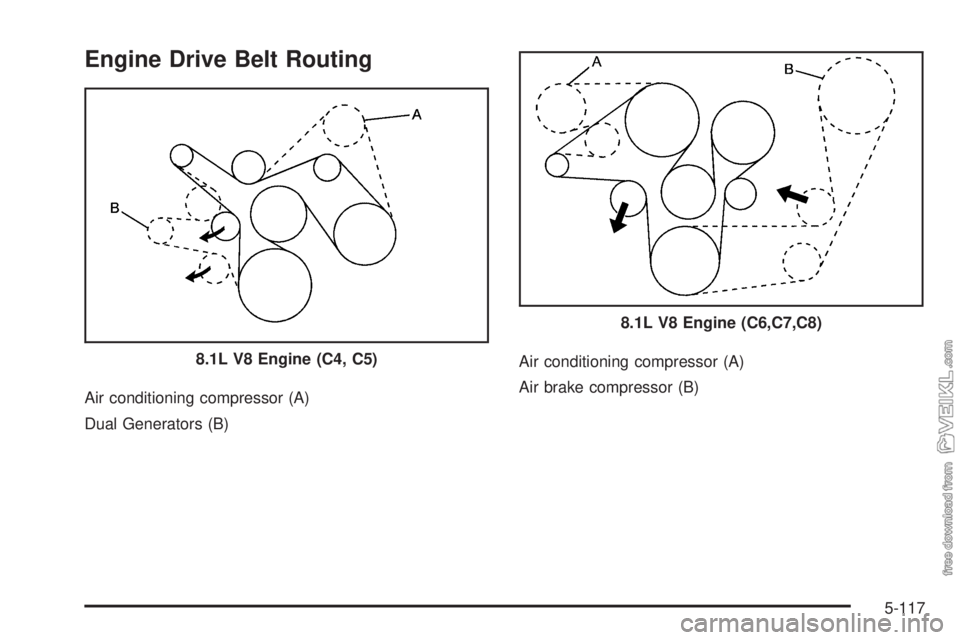
Engine Drive Belt Routing
Air conditioning compressor (A)
Dual Generators (B)Air conditioning compressor (A)
Air brake compressor (B) 8.1L V8 Engine (C4, C5)
8.1L V8 Engine (C6,C7,C8)
5-117
Page 322 of 384
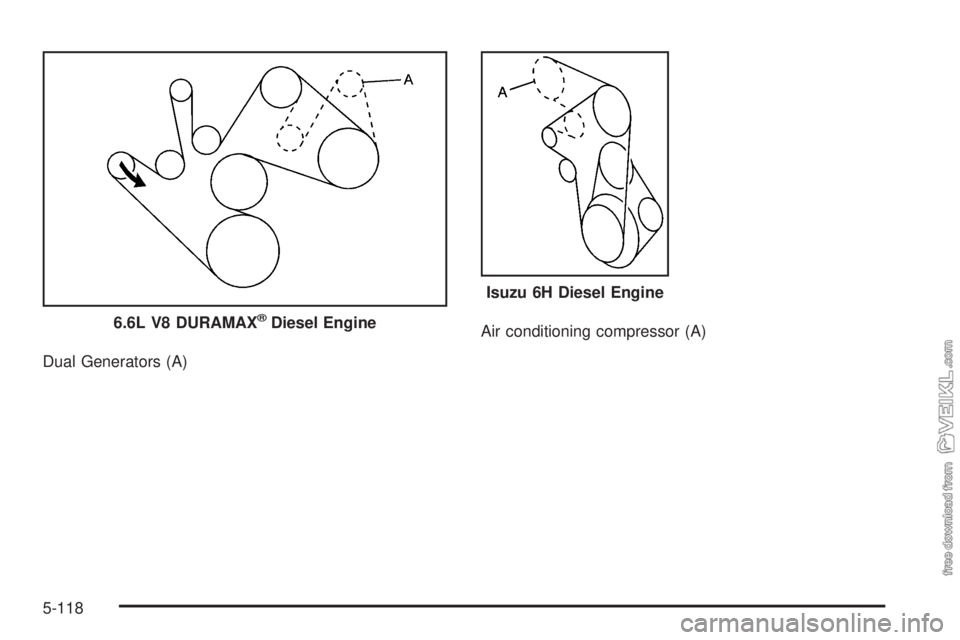
Dual Generators (A)Air conditioning compressor (A) 6.6L V8 DURAMAX
®Diesel Engine
Isuzu 6H Diesel Engine
5-118
Page 323 of 384
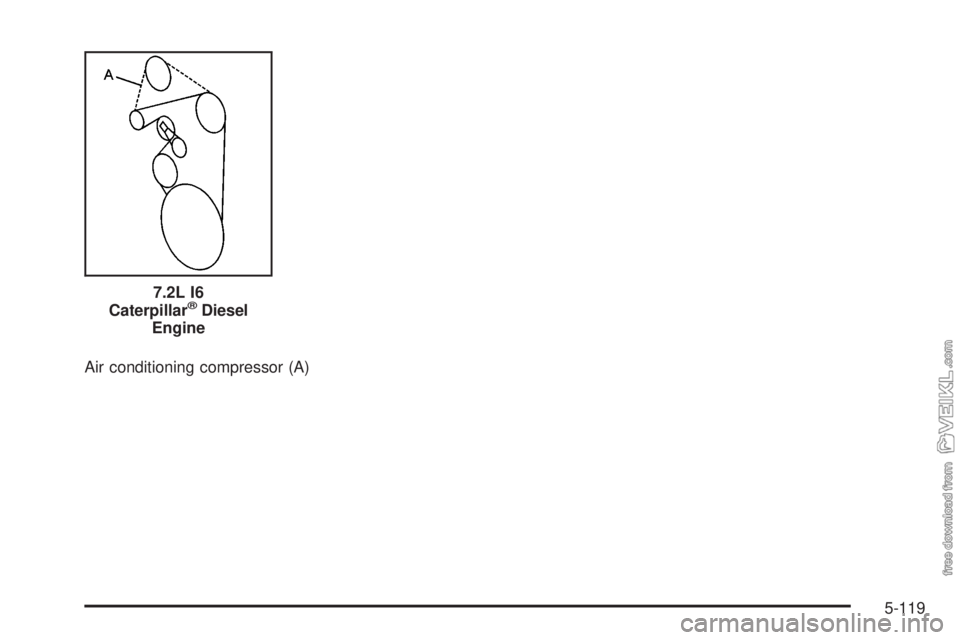
Air conditioning compressor (A)7.2L I6
Caterpillar
®Diesel
Engine
5-119